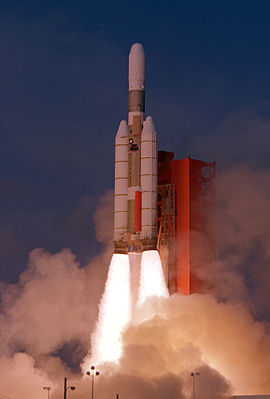Titan IIIC

Launch of a Titan IIIC
|
|
| Function | Medium/Heavy launch vehicle |
|---|---|
| Manufacturer | Martin |
| Country of origin | United States |
| Size | |
| Height | 137 ft (42 m) |
| Diameter | 10 ft (3.05m) |
| Mass | 1,380,510 lb (626,190 kg) |
| Stages | 2-3 |
| Capacity | |
| Payload to LEO | 28,900 lb (13,100kg) |
| Payload to GTO |
6,600 lb (3,000 kg) |
| Payload to Mars |
2,650 lb (1,200 kg) |
| Associated rockets | |
| Family | Titan |
| Launch history | |
| Status | Retired |
| Launch sites |
LC-40 & 41, CCAFS SLC-6, Vandenberg AFB (unused) |
| Total launches | 36 |
| Successes | 31 |
| Failures | 5 |
| First flight | 18 June 1965 |
| Last flight | 6 March 1982 |
| Boosters (Stage 0) - UA1205 | |
| No. boosters | 2 |
| Thrust | 1,315,000 lbf (5,850 kN) |
| Specific impulse | 263 secs |
| Burn time | 115 seconds |
| Fuel | Solid |
| First stage | |
| Engines | 2 LR87-11 |
| Thrust | 526,000 lbf (2,340 kN) |
| Burn time | 147 seconds |
| Fuel | Aerozine-50/N2O4 |
| Second stage | |
| Engines | 1 LR91-11 |
| Thrust | 102,000 lbf (450 kN) |
| Burn time | 205 seconds |
| Fuel | Aerozine-50/N2O4 |
| Upper stage - Transtage | |
| Engines | 2 AJ-10-138 |
| Thrust | 16,000 lbf (71 kN) |
| Burn time | 440 seconds |
| Fuel | Aerozine 50/N2O4 |
The Titan IIIC was an expendable launch system used by the United States Air Force from 1965 until 1982. It was the first Titan booster to feature large solid rocket motors and was planned to be used as a launcher for the Dyna-Soar and Manned Orbiting Laboratory, though both programs were cancelled before any astronauts flew. The majority of the launcher's payloads were DoD satellites, namely for military communications and early warning, though one flight (ATS-6) was performed by NASA. The Titan IIIC was launched exclusively from Cape Canaveral while its sibling, the Titan IIID, was launched only from Vandenberg AFB.
The Titan rocket family was established in October 1955 when the Air Force awarded the Glenn L. Martin Company (later Martin Marietta and now Lockheed Martin) a contract to build an intercontinental ballistic missile (SM-68). It became known as the Titan I, the nation's first two-stage ICBM, and replaced the Atlas ICBM as the second underground, vertically stored, silo-based ICBM. Both stages of the Titan I used kerosene (RP-1) and liquid oxygen (LOX) as propellants. A subsequent version of the Titan family, the Titan II, was similar to the Titan I, but was much more powerful. Designated as LGM-25C, the Titan II was the largest USAF missile at the time and burned Aerozine 50 and nitrogen tetroxide (NTO) rather than RP-1 and LOX.
...
Wikipedia
